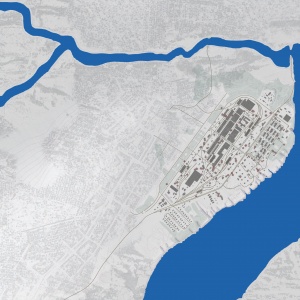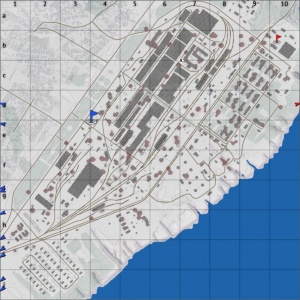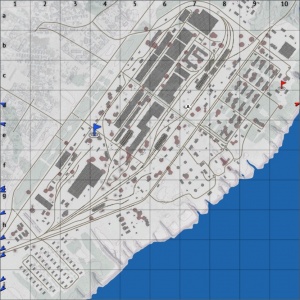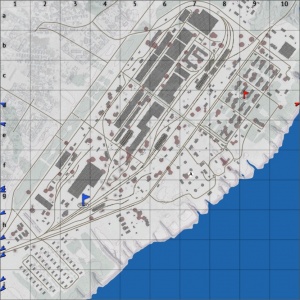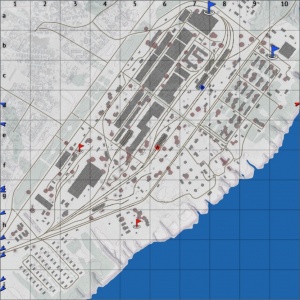Stalingrad Factory
| Game Modes | ||||
|---|---|---|---|---|
Contents
Overview
Stalingrad Factory, or simply Stalingrad is a ground forces map available in all modes. It was added in Update 1.53 "Firestorm". As the name of the map suggests it is set in Stalingrad. The map is set around a heavily damaged factory complex, combat generally takes place at short range. The map can be split into three distinct diagonal strips.
The northwest most strip consists of three rows of destroyed factory buildings. The roads between some of the buildings are blocked so players must either pick a different route or drive through the inside of the buildings where possible. The area offers good opportunities to ambush players by hiding among rouble our inside / behind the buildings. Some of the buildings have sheet metal walls / roofs which can be shot through and destroyed.
The middle strip consists of a rail yard; it is more open than the factory complex and allows for players to make some longer range shots down the rail lines. Many of the train cars can be shot through to kill unsuspecting tanks.
The southeast most strip is more open than the other two. It starts out in the north east with destroyed residential buildings, then transitions into a more open oil storage area, and finally an open area, with sparsely placed buildings.
The tank battles map is technically 4km x 4km, however only a small section of the map (less than 2km x 2km) is modelled to tank map quality and available to play in. The air battles map is 65km x 65km.
Game Description
Historical Background
The map is a mostly accurate recreation of the Dzerzhinsky Tractor Factory (often referred to as the Stalingrad Tractor Plant, and today the Volgograd Tractor Plant), depicting it in a heavily damaged state.
The battle of Stalingrad has become one of the most infamous battles of WW2. It is widely considered to be the single largest and bloodiest battle in the history of warfare. Over a 5 month period the battle involved nearly 2.2 million soldiers and is believed to have killed nearly 2 million people.
German forces entered the City on the 12th September 1942. The battle in the city was the scene of intense fighting. During the now infamous battle at Mamayev Kurgan and Railway Station No. 1 the fighting was so intense that the station changed hands 14 times in just a 6 hour period. German forces entered the Dzerzhinsky Tractor Factory (where this map is based) on the 4th of October 1942 and were repulsed by Soviet forces, while the battle was going on the factory continued to produce T-34s. On the 14th and 15th October the factory came under near constant bombardment from the German Luftwaffe, with over 900 individual sorties being flown, but again continued production. Tanks were being driven straight off the production lines and into the battle, the plant reportedly continued producing tanks right up until German forces overran the production lines.
The Soviet counter offensive code-named Operation Uranus was launched on 19th November 1942. Two spearheads were launched from 80km (50 miles) north and south of the German positions, attacking the weak flanks of the German forces. The Germans did not believe the Soviets were capable of carrying out a large scale counter attack, and so their flanks were left weakly defended by weakly defended by Romanian, Hungarian, and Italian troops; who were overstretched and lacking supplies. By the 23rd of November the Soviet forces had linked up about 100km (60 miles) west of Stalingrad encircling 250,000 - 300,000 German troops.
The German high command urged Hitler to allow the trapped forces to break out and rejoin the main German forces west of the city, but Hitler would not allow a retreat and ordered that the men “stand and fight”. Hitler declared that the Army would be supplied by the Luftwaffe, but it was only possible to provide a fraction of the needed supplies by air drop.
In mid-December Hitler ordered Field Marshal Erich von Manstein (one of Germany's most-talented commanders) to form a special army corps to rescue the trapped forces by fighting its way eastward, through the soviet lines. However Hitler again refused to let the trapped forces breakout to meetup with their rescuers. The operation (code named Operation Winter Storm) was launched on 12th December 1942. Hitler's insistence that the tapped forces not attempt to fight their way westward doomed the operation as Manstein’s forces lacked the resources needed to break through the Soviet encirclement on their own. The assault was called off on the 23rd of December 1942.
The Soviets launched their operation to shrink the pocket of encirclement on the 16th December 1942, and after one and a half months of fighting the German forces surrendered on the 2nd of February 1943, ending the Battle of Stalingrad.
Notable Landmarks
Map configuration
Domination
There are three capture points. Point A is in a destroyed building in the north of the map, B is in the rail yard in the middle of the map, and C is among the oil tanks in the south.
Conquest
There are three configurations of the Conquest mode, each with one capture point. The point will be near the position of one of the Domination capture points.
Battle
There are two capture points, each belonging to a team. The points are located at two different points in the rail yard area of the map.
Strategy
Describe what focus a team should have when spawning into the map
Media
See also
Links to the articles on the War Thunder Wiki that you think will be useful for the reader, for example:
- reference to related locations


